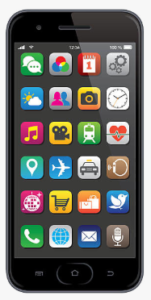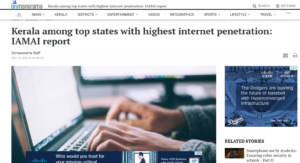We are in an era of sweeping changes brought about by technology and mobility. We see that Industry 4.0 and digital proliferation is becoming the mainstay of the knowledge era, leading to the emergence of a new breed of knowledge workers. In the vast and fast moving digital space, it is a host of factors working in combination, than a single, dominant cause which is effecting a change of such scale and magnitude. The plethora of growth drivers combined with socio-economic-technological changes, behavioural patterns and media consumption habits, all are leading us invariably to a new order. In a nutshell, we can encompass them into the following.
Growth of digital characterised and aided by :
- Sustainable Growth Drivers
- Changing Consumer Behaviour
- Emergence of Research-based Buying Habits
Sustainable Growth Drivers for Digital
We basically understand that there are four powerful forces which is triggering this massive adoption of digital platforms and consequently the online content consumption.
a) Affordability and Penetration

The device penetration led by 5G/4G/3G mobility technologies and their massive adoption has made smartphone a household name. The day is not far when each Indian would be having a smart device in his pocket. The affordability of smartphone has revolutionised media consumption habits in our country as well as across the world. Currently the average price of smartphone (ASP) is at Rs 11,263/-. It has been steadily coming down with ever- increasing features and performance parameters, hence it has now acquired a ‘necessary status’, being no longer viewed as a luxury device. The smartphone ownership is expanding, and is currently slated at 50 crore smartphone owners in India.
b) Sharp fall in mobile data prices

The entertainment seeking population with high sociability index in our country has been looking for a break-out pricing in data charges, which arrived with the entry of the new operator and consolidation in wireless telecommunications sector. Data prices which were prohibitively expensive at Rs 226/GB in 2015 has hit the base rate of Rs 11.78/GB in 2020. This price drop has unleashed a wave of adoption and consumption, and triggered setting up of new social and business models across the country. Studies indicate that heavy internet users, use as high as 4.3 hours every day on the mobile, this kind of disproportionate usage can be led and fed only by base rates of data pricing and content consumption.
c) Technology and User-friendliness

Smartphone has established itself as the primary device to enter the communication, media and entertainment spaces for a big segment of the population. This has heralded advent of mobile phone technologies, the features of which are user-friendly and intuitive for the consumer. The versatility of the technology has been democratized with many start-ups in the development space, vying for attention. The feature-rich yet simple interfaces have made user generated content creation an easy and popular activity. These ‘affordances’ in the technology has delivered penetration and personalisation.
d) User Generated Content

User Generated Content (UGC) refers to any form of content made by the user and posted by the user in social media. It can be text, image, video, audio etc. It is personal and non-paid. Social media users are able to post highly localised content online, sheer ground-level nature of such posts ensures it is contextual and relevant in social media marketing. The technology and media affordances are shaping this online behaviour and content marketing strategy, creating massive UGC generation and equally voluminous consumption in a virtuous cycle. It is very simply unpaid advertising and an effective one at that; whilst being hugely scalable with the ability to go viral organically and deliver reach and engagement.
Changing Consumer Behavior
It is interesting to analyse how the customers are spending time on the internet, and the dominance of search and social media is clearly represented. to a new order.

a) Growing Internet usage leading to ‘Digital First’

The internet penetration of the country stands at 40% as per the Internet and Mobile Association of India report, Nov’2019. Among the states, National Capital Territory of Delhi is at the top with 68% penetration while Kerala is second at 56%. The states with major IT hubs, Tamil Nadu and Karnataka is at 49% and 42% respectively.
This is important trend and to be read along with the fact that 97% of internet usage is happening on the mobile device. Here mobile is spearheading the internet penetration, it is also replacing traditional media as the preferred media of consumption and choice. This in fact is largely led by the social media platforms and lifestyle apps which are best suited for interaction through the mobile, in turn further boosting the popularity.
b) Social Media Usage

When we talk about heavy mobile data users spending 4.3 hour on the mobile device, what is leading to this addictive consumption behavior? The answer lies in the power of social media and entertainment, provided in capsule form in the mobile screens. Facebook users have reached 2,450 million in 2019, growing at a frenetic pace of 68% growth rate year on year. Same is the case with Instagram, the photo-sharing app, which was launched in 2010, now with an impressive 1000 million users.
It is estimated that 70% of data usage is on social media and entertainment. This powerful fact reflects the vibrant eco-system and the digital screen led by the mobile taking prime place. The digital content has to reflect these changing realities and the digital marketer has to be aware and act on these new trends with a holistic and decisive approach.
Emergence of Research-based Buying
There is a radical yet sustainable shift in the consumer behaviour as he or she is empowered with a host of digital tools and online information, in a data intensive and digitally powered marketplace. This has led to quantum shifts in the customer buying journey.
Digital Persuasion – Research Findings
- 81% customers go online before heading to a store. In addition to this, 35% intentionally carry smartphone while shopping to compare online and offline prices and arbitrage opportunity.
- 97% customers turn to a search engine when buying a product. It is estimated that 15% turn to social media for product details and related information.
- Online reviews impact 67% of respondent’s purchasing decisions. This is a testimony to the power of social proof which has been amplified with the social media penetration.
- 64% people are more likely to buy a product after they watch a video. This emphasises the need for video marketing, especially the explainer video formats which are quite useful to explain feature-rich and multi-modal services.
All these key changes are leading to a ‘Digital First’ World, where digital content is accessed first in terms of data, information and entertainment. Imaginative and versatile content creation and content marketing is enabling the access and usage. This in turn is further driving penetration and creation of newer tools and devices. It is a virtuous cycle which is irrevocably and profoundly changing the fundamentals of information and communication.
About the Authors
Jimmy George C.

Jimmy George is a seasoned marketer and brand builder with more than 18 years experience in product marketing domain, with expertise in content marketing and digital customer acquisitions. He is the Business Head and Managing Partner of ByGeorge Content Solutions, a content creation and content marketing firm. He can be reached at jimmygeorge@bygeorge.in
Smruti Ranjan Mallick

Smruti Ranjan Mallick is an experienced marketer with expertise in product marketing, consumer analytics and segmentation, and brand management. His areas of interest are behavioral economics, neurosciences and strategic decision making. He is currently leading growth marketing at PayTM.


